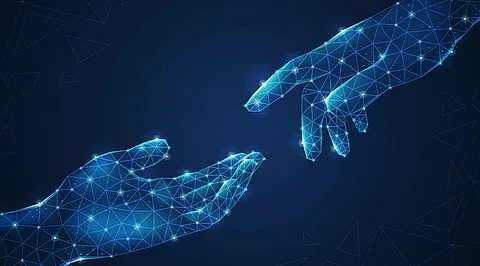

In his 1993 book Mirror Worlds, computer scientist, and Yale University professor David Gelernter imagined a future (relatively near, he thought) in which we could explore an entire city as it exists from moment to moment while sitting in front of a computer. He also speculated that physical reality will eventually be replaced, one piece at a time, by a software imitation that we will all "live in." While his more extravagant speculations remain in the realm of science fiction, his idea of "Mirror Worlds" is being realized in an increasing number of industries through the concept of a "digital twin."
As the name implies, a digital twin is basically a virtual, dynamic representation of an actual or potential entity, process, or system in the physical world. The concept was first introduced in 2002 at a conference of the Society of Manufacturing Engineers. In a University of Michigan presentation on Product Lifecycle Management (PLM), a slide prepared by Professor Michael Grieves referred to the "Conceptual Ideal for PLM," which was depicted as a car in "Real Space" and an identical car in "Virtual Space" with data and information flowing between the two spaces over time. The concept was formalized as the "Mirrored Spaces Model," which posited the existence of two "systems"—the physical system and a mirror-image virtual system—that would be dynamically linked throughout the four lifecycle phases of creation, production, operation, and disposal. The model was later expanded, and the virtual system came to be referred to as the "digital twin" of the physical system.
The digital twin concept has since gained increasingly wider attention. Aided by increases in computing power and the advent of new technologies in areas such as data collection and AI analytics, use cases for digital twins have been identified in the aerospace, automotive, energy, healthcare, and construction industries, as well as in urban planning and other endeavors. The characteristics and information requirements of a particular digital twin will depend on the use case. While a comprehensive discussion of the existing and possible uses of digital twins is beyond the scope of this article, one example of an existing use is General Electric's digital twins of its aircraft engines, which allow real-time monitoring of each engine's performance and the prediction of needed maintenance. Looking ahead, Professor Grieves sees "intelligent" digital twins that can themselves predict the future and fix problems before they occur as the next stage in the evolution of the concept. We will also see the application of the concept to humans. Leading IT research and advisory firm Gartner has identified digital twins of humans (particular bodily organs, for example) as one of five emerging trends that will drive technology innovation for the next decade.
My firm, DataArt, a global custom software developer, has played a key role in bringing digital twin technology to bear on the inspection of bridges, tunnels, and other critical public infrastructure, which leaves no room for failure. The story begins in 2019 with the founding of our client STRUCINSPECT, a joint venture among manufacturer PALFINGER, engineering specialists VCE, and the mobile mapping and photogrammetry experts of the ANGST Group. STRUCINSPECT's founders recognized that, like many other traditionally manual processes, infrastructure inspection had the potential to be dramatically improved through the integration of new technologies. With DataArt's help, they began developing the technology for "digital inspection," the core of which is the AI-assisted inspection of an infrastructure asset's digital twin. Essentially, the technology involves the transformation of 2D images captured by a drone flying around a structure into an extraordinarily accurate 3D model that can be inspected digitally rather than physically.
As of today, STRUCINSPECT's AI module has been trained to detect five distinct types of damage to concrete surfaces, including fine cracks and corrosion. Using the STRUCINPECT platform, a human engineer can examine the structure in a thumbnail and zoom in to inspect any damage up close, even while working remotely and regardless of light or weather conditions. The platform also enables inspection teams to classify, log, and filter identified damage, while an intuitive dashboard allows owners and operators of infrastructure assets to easily see and track the evolution of damage by type.
The STRUCINSPECT platform represents a major advance over the traditional, fully manual inspection process, which is labor-intensive, time-consuming, and expensive, not to mention disruptive if a bridge or tunnel needs to be closed while an inspection is conducted. Inspection of a structure's digital twin has already proven its value as a highly efficient solution for clients such as ÖBB Infra and the Autobahn Südbayern in projects in Germany, Croatia, parts of Scandinavia, and Austria. But this is by no means the end of the story. Evermore powerful features are being continuously added, and, in the future, the system will be able to predict when maintenance should be performed and will allow end-users themselves to train the software's AI module to identify additional types of defects and damages.
The unrealized potential for digital twins is immense and hard to fathom. Even if we do not end up inhabiting the "Mirror Worlds" of Gelernter's speculations, it is safe to say that digital twins will become ever more prevalent and play an increasingly important and disruptive role in more and more industries.
by Alexander Makeyenkov, Managing Director of DataArt DACH
Join our WhatsApp Channel to get the latest news, exclusives and videos on WhatsApp
_____________
Disclaimer: Analytics Insight does not provide financial advice or guidance. Also note that the cryptocurrencies mentioned/listed on the website could potentially be scams, i.e. designed to induce you to invest financial resources that may be lost forever and not be recoverable once investments are made. You are responsible for conducting your own research (DYOR) before making any investments. Read more here.
